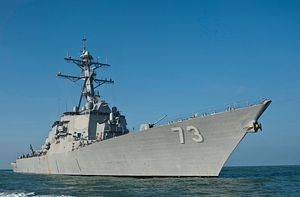On Friday, October 21, a U.S. Navy destroyer sailed near features in the Paracel Islands, challenging “excessive maritime claims” as part of a freedom of navigation operation (FONOP), Reuters reported, citing U.S. officials.
The USS Decatur, an Arleigh Burke-class guided missile destroyer sailed near China-occupied features in the Paracel Islands that are also claimed by Vietnam and Taiwan. The destroyer specifically sailed near Triton Island and Woody Island, but did not sail within 12 nautical miles of either feature.
The operation is the fourth U.S. FONOP in the South China Sea since last year and the first since an international tribunal released a landmark ruling in a case between the Philippines and China, finding China’s capacious nine-dash line claim in the South China Sea invalid.
On October 27, 2015, the USS Lassen sailed within 12 nautical miles of Subi Reef and other features in the Spratly Islands.
On January 30 this year, the USS Curtis Wilbur sailed within 12 nautical miles of Triton Island, challenging prior notification requirements for innocent passage.
Finally, on May 10, the USS William P. Lawrence sailed within 12 nautical miles of Fiery Cross Reef.
Two points stand out immediately about Friday’s FONOP. First, as I’ve discussed before at The Diplomat, though the U.S. Navy sought to stage FONOPs regularly in the South China Sea, an unusually long period of time elapsed between the William P. Larence‘s FONOP and the Decatur‘s operation on Friday.
Specifically, while only 95 days elapsed between the Lassen’s operation and the Curtis Wilbur‘s operation, and 105 days elapsed between the Curtis Wilbur‘s operation and the William P. Lawrence FONOP, Friday’s operation comes 164 days after the most recent publicly reported South China Sea FONOP.
It is possible that the U.S. Navy could have conducted FONOPs without ever publicizing them in the meantime, but all previous operations have drawn a reaction from the Chinese foreign ministry.
It’s unclear that China would choose not to draw attention to a U.S. FONOP given its assertion that the activities represent “militarization” in the South China Sea.
Second, it’s notable that the USS Deactur reportedly did not sail within 12 nautical miles of Triton Island given that the January FONOP challenged prior notification requirements by China by carrying out an innocent passage through Triton’s claimed territorial sea.
The decision to sail near Woody Island is notable as well. Woody Island is the largest naturally formed island in either the Spratly or Paracel group and is a major Chinese military outpost with a permanent posting of some 1,400 personnel.
Beijing has drawn attention for placing advanced military assets on Woody Island, including surface-to-air missile systems, anti-ship cruise missiles, surveillance drones, and multi-role fighters.
As of this writing, the Chinese foreign ministry has not publicly reacted to the USS Decatur‘s FONOP in the Paracel Islands. China reacted to the FONOP by having three vessels shadow the U.S. destroyer, a source told Reuters.
































